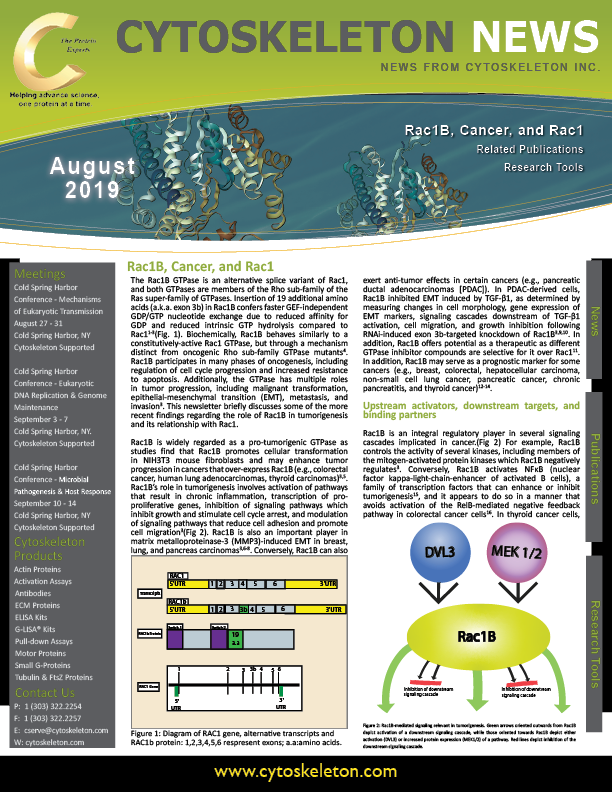August 2019 Newsletter Rac1B, Cancer, and Rac1
- By Cytoskeleton Inc. - Small G-Protein News
- Aug 6, 2019

The Rac1B GTPase is an alternative splice variant of Rac1, and both GTPases are members of the Rho sub-family of the Ras super-family of GTPases. Insertion of 19 additional amino acids (a.k.a. exon 3b) in Rac1B confers faster GEF-independent GDP/GTP nucleotide exchange due to reduced affinity for GDP and reduced intrinsic GTP hydrolysis compared to Rac11-3(Fig. 1). Biochemically, Rac1B behaves similarly to a constitutively-active Rac1 GTPase, but through a mechanism distinct from oncogenic Rho sub-family GTPase mutants4. Rac1B participates in many phases of oncogenesis, including regulation of cell cycle progression and increased resistance to apoptosis. Additionally, the GTPase has multiple roles in tumor progression, including malignant transformation, epithelial-mesenchymal transition (EMT), metastasis, and invasion3. This newsletter briefly discusses some of the more recent findings regarding the role of Rac1B in tumorigenesis and its relationship with Rac1.
Rac1B is widely regarded as a pro-tumorigenic GTPase as studies find that Rac1B promotes cellular transformation in NIH3T3 mouse fibroblasts and may enhance tumor progression in cancers that over-express Rac1B (e.g., colorectal cancer, human lung adenocarcinomas, thyroid carcinomas)3,5. Rac1B’s role in tumorigenesis involves activation of pathways that result in chronic inflammation, transcription of pro-proliferative genes, inhibition of signaling pathways which inhibit growth and stimulate cell cycle arrest, and modulation of signaling pathways that reduce cell adhesion and promote cell migration3(Fig 2). Rac1B is also an important player in matrix metalloproteinase-3 (MMP3)-induced EMT in breast, lung, and pancreas carcinomas3,6-8. Conversely, Rac1B can also exert anti-tumor effects in certain cancers (e.g., pancreatic ductal adenocarcinomas [PDAC]). In PDAC-derived cells, Rac1B inhibited EMT induced by TGF-β1, as determined by measuring changes in cell morphology, gene expression of EMT markers, signaling cascades downstream of TGF-β1 activation, cell migration, and growth inhibition following RNAi-induced exon 3b-targeted knockdown of Rac1B3,9,10. In addition, Rac1B offers potential as a therapeutic as different GTPase inhibitor compounds are selective for it over Rac111. In addition, Rac1B may serve as a prognostic marker for some cancers (e.g., breast, colorectal, hepatocellular carcinoma, non-small cell lung cancer, pancreatic cancer, chronic pancreatitis, and thyroid cancer)12-14.
Also included in this newsletter:
- Tubulin and Actin Live Cell Reagents, G-LISA Activation Assay Kits, Tubulin Kits, Actin Biochem Kits
- Related Publications

